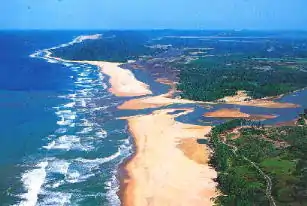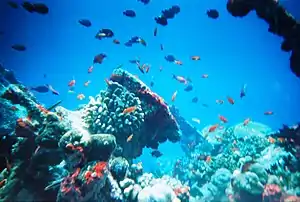Hydrobiology
Hydrobiology is the science of life and life processes in water. Much of modern hydrobiology can be viewed as a sub-discipline of ecology but the sphere of hydrobiology includes taxonomy, economic biology, industrial biology, morphology, physiology etc. The one distinguishing aspect is that all relate to aquatic organisms. Much work is closely related to limnology and can be divided into lotic system ecology (flowing waters) and lentic system ecology (still waters).
One of the significant areas of current research is eutrophication. Special attention is paid to biotic interactions in plankton assemblage including the microbial loop, the mechanism of influencing water blooms, phosphorus load and lake turnover. Another subject of research is the acidification of mountain lakes. Long-term studies are carried out on changes in the ionic composition of the water of rivers, lakes and reservoirs in connection with acid rain and fertilisation. One goal of current research is elucidation of the basic environmental functions of the ecosystem in reservoirs, which are important for water quality management and water supply.
Much of the early work of hydrobiologists concentrated on the biological processes utilised in sewage treatment and water purification especially slow sand filters. Other historically important work sought to provide biotic indices for classifying waters according to the biotic communities that they supported. This work continues to this day in Europe in the development of classification tools for assessing water bodies for the EU water framework directive.
The hydrobiologist technician conducts field analysis. It identifies plants and living species, locates them, counts them. It identifies pollutions and nuisances that can affect the aquatic fauna and flora. He takes the samples and writes a report of his observations.
The hydrobiologist engineer intervenes more in the process of the study. It defines the intervention protocols, the samples to be taken. He plans and programs the study campaigns and then summarizes his results. In the event of pollution, it proposes solutions to improve the biological quality of water within the framework of the regulations in force and the available means. In the case of complex programs, the hydrobiologist can work in a multidisciplinary team with botanists, zoologists
The hydrobiologist works on behalf of large public institutions of a scientific and technological nature (CNRS, INRA, IRD, CIRAD, IRSTEA ...), public institutions (Water Agencies, Regional Directorates environment, Higher Council of Fisheries, CEMAGREF ...), companies (EDF, Veolia environment, Suez environment, Saur, ...), local authorities, research departments, associations (Federations of fishing, Permanent Centers for Environmental Initiatives ...).
Training and studies
The biologist technician usually has a training level bac +2 or bac +3:
- DUT biological engineering options biological and biochemical analyzes (ABB), environmental engineering,
- BTSA water professions,
- BTS GEMEAU - water management and control,
- BTS and regional controls,
- BTSA Agricultural, Biological and Biotechnological Analyzes (ANABIOTEC),
- DEUST analysis of biological media,
- Bachelor's degree in biology
The engineer in hydrobiology has a training level bac +5:
- engineering school diploma: INA, ENSA, Polytech Montpellier sciences and water technologies,
- master's degree in environmental sciences or biology (training examples):
environmental management and coastal ecology (University of La Rochelle),
biology of organisms and populations (University of Burgundy),
continental and coastal environments sciences Environment, Soils, Waters and Biodiversity (University of Rouen),
operation and restoration of continental aquatic environments (University of Clermont Ferrand), etc.
Field of research interests
The following are the research interests of hydrobiologists:
- acidification impact on lake and reservoir ecosystems
- ocean acidification
- paleolimnology of remote mountain lakes
- molecular ecology, phylogeography and taxonomy of Cladocera
- ultramorphology of cladoceran limbs and feeding adaptations
- chemical communication in plankton (prey-predator interaction)
- biomanipulation of water reservoirs
- cyclus of major nutrients (phosphorus, nitrogen)
- self-controlling mechanisms at population and community level
Organizations
- American Society of Limnology and Oceanography (ASLO)
- International Association of Theoretical and Applied Limnology (SIL)
- American Fisheries Society
- Freshwater Biological Association, England
- Marine Biological Laboratory (USA)
- Australian Society for Fish Biology
- Fisheries and Marine Institute of Memorial University of Newfoundland
- Department of Hydrobiology (Charles University, Prague)
- Dresden University of Technology Institute of Hydrobiology
- Institute of Hydrobiology and Fishery Science
- Water Research Institute T.G.M.
- Hydrobiological Institute, Academy of Science of Czech Republic
- Research Institute of Fish Culture and Hydrobiology
- Department of Hydrobiology, Slovak Academy of Science, Bratislava, Slovakia
- Max-Planck-Institut fur Limnologie in Ploen, Germany
- CNR-Istituto Italiano di Idrobiologia
- Institute of Hydrobiology, Chinese Academy of Sciences
- Hydrobiology Pty Ltd Brisbane, Australia based private consulting company
- Institute of Zoology and Hydrobiology University of Tartu, Estonia
- Department of Hydrobiology Bulgarian Academy of Sciences
- Department of General and Applied Hydrobiology Faculty of Biology, Sofia University "Sveti Kliment Ohridski", Bulgaria
Journals
Notable researchers
References
- E.P.H. Best (Editor), Jan P. Bakker (Editor) Netherlands-Wetlands (Developments in Hydrobiology series) (Kluwer Academic Publishers, Dordrecht, 1993, 328 pp) ISBN 0-7923-2473-0
- R.I. Jones (Editor), V. Ilmavirta (Editor) Flagellates in Freshwater Ecosystems (Developments in Hydrobiology series) (Kluwer Academic Publishers, Dordrecht, 1992, 498pp.) ISBN 90-6193-651-9
- Jürgen Schwoerbel Methods of hydrobiology (freshwater biology) (Pergamon Press; [1st English ed.] edition, 1970, 200pp.) ISBN 0-08-006604-6
- Hydrobiologist by Josée Lesparre © CIDJ - 09/2019
External links
- Hydrobiology website Website for Hydrobiology, Aquacultures, Ichthyology, Water purification and Biological Oceanology - Bulgaria.
- The International Congress on the Biology of Fish
- Annual Larval Fish Conference
- Annual Northeast Fish and Wildlife Conference
- The Waterrose Aquatic Ecology Page
- Developments in Hydrobiology-Springer Book Series Prints proceedings for international conferences on Hydrobiology

